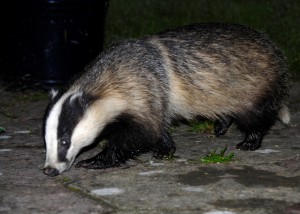 Badgers are encountered in all districts of the region. They dwell in the edges of coniferous, deciduous and mixed forests. The species claims dry parts, unattended by people, hilly and often sandy forest plots with a hidden passage to water front. In places most convenient several families settle in, forming the so-called badger setts. The residence itself is a complex underground system with a network of entrances and exits, and two or three nesting chambers, layered and stretching 5-10 meters from the entrance. Having stored enough fat during the summer and fall, the badger hibernates until April. Badgers are omnivorous. The main share of forage is rodents (mice and voles) and soil insects. They exterminate numerous May beetles, mole crickets, longhorns and other insects damaging the forests. Insects may comprise up to 95% of their diet. They hunt them digging up soil. Badgers are rare; therefore, this useful animal must be protected from poachers and provided with necessary proliferation conditions.
Badgers are encountered in all districts of the region. They dwell in the edges of coniferous, deciduous and mixed forests. The species claims dry parts, unattended by people, hilly and often sandy forest plots with a hidden passage to water front. In places most convenient several families settle in, forming the so-called badger setts. The residence itself is a complex underground system with a network of entrances and exits, and two or three nesting chambers, layered and stretching 5-10 meters from the entrance. Having stored enough fat during the summer and fall, the badger hibernates until April. Badgers are omnivorous. The main share of forage is rodents (mice and voles) and soil insects. They exterminate numerous May beetles, mole crickets, longhorns and other insects damaging the forests. Insects may comprise up to 95% of their diet. They hunt them digging up soil. Badgers are rare; therefore, this useful animal must be protected from poachers and provided with necessary proliferation conditions.
/ * The photos at lake.peipsi.org are cross-posted from commons.wikimedia.org and are used for familiarization purposes only. No commercial use of the photos is allowed. For more information about to use the photos see the originals on commons.wikimedia.org. /


